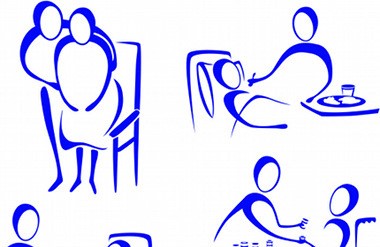Diabetes helpful tips – A caregivers guide

Diabetes is a chronic medical condition, which can severely affect the physical and emotional condition of a patient. Family/partners of people living with diabetes may sometimes find caregiving an overwhelming experience, because of the exhaustive demands in diabetes management. They often undergo emotional, mental and physical stress.
Read on to find out what you can do & how you can cope.
Enlighten yourself:
According to ADA, partners/caregivers who do their own little research in diabetes are more equipped and apt in managing diabetes well. Knowing a various aspects of diabetes like what food can be consumed and what self measures one can take to prevent diabetes. Studies reveal books, medical online sites, diabetes communities can be of great help in enlightening about diabetes. Caregivers may also consult a certified diabetes educator to educate themselves about the Do, s and Don’ts of caregiving for people with diabetes.
Avoid “miscarried helping”:
Research suggests, too much nagging can back fire in diabetes management. Psychologist Gerald Straus, calls too much nagging “miscarried helping”.You may be having every intention to help your partner/ patient but studies reveal, miscarried helping may lead your loved ones runningin just the opposite direction”, leading to very poor diabetes management.
Kindness matters:
Research suggests imposing rules and executing doctor’s instructions in the wrong tone or dialect may rub the patient/partner in all the wrong ways. Studies reveal explaining things compassionately, like what you would appreciate your partner/patient to do, and what may disappoint you, can get you better results in treatment compliance. Dr Strauss, ADA suggests, you can take additional help from expert diabetes educators to ensure your approach is well received and followed.
On the other hand, with children, and adolescents one has to supervise, and sometimes might have to be a little strict to ensure treatment compliance..
Bring in changes together:
Research suggests bringing in necessary lifestyle changes in your life too can help enormously to motivate your partner/patient living with diabetes. By adopting healthy changes together, like eating the same diet, one can manage the conditions better, because people living with diabetes will have company, in making efforts to lead a healthy lifestyle. You may choose to make a few sacrifices to let the patient/spouse you are caring for, know that you are fully committed to the diabetes management programme. A caregiver’s role is one of the most important aspects in diabetes management. A compassionate and well understanding partner can help in addressing the diabetes issues more effectively.
Share your feelings:
We understand that caregiving can be stressful at times. Research suggests, caregivers may often suffer from compassion fatigue and burnout. Compassion fatigue is a common condition observed in medical professionals, nurses, and caregivers.
Dr Charles Figley Professor from New Orleans LA defines, compassion fatigue as a state experienced by caregivers, who are preoccupied in constantly caring for patients, which leads to a degree of self-distress, creating a secondary traumatic condition in the caregiver/helper. Hence, it is most important for a caregiver to stay calm, stress free during the diabetes care for the partner.
Feel free to share your feelings with your spouse/patients/doctors whenever you feel absolutely exhausted. Speaking your heart out can be a very good way to lighten up yourself. There are several ways of coping up with compassion fatigue such as taking up recreational activities, outings with the patient/family, yoga & meditation. You may also choose to seek medical advice if you are completely undergoing burn out.
Make feasible plans
According to the American diabetes association-Setting up realistic goals and taking a step-by-step approach is the easiest and the best way to incorporate lifestyle changes. For example, doing small things at first, like including a 45 minute walking regime daily, may lower your partner/patient blood sugar levels, which can motivate your partner/patient to embrace further inclusions of the diabetes programme. A daily regular regimen followed can help in alleviating the much caused anxiety and helps in keeping a check on the spiked glucose levels.
Make meals interesting:
Studies reveal that meals have been always an area of interest for people with diabetes. Nothing should come your way in serving tasty food, keeping diabetes in mind. Stock your kitchen with healthy fruits and vegetables, so that you can always quickly prepare an interesting snack or meal for frequent munching.
You may want to check out our diabetes friendly recipes, before you step out to shop for grocery for yourself and your partner. We recommend you to have a look at the section-Food as Medicine where our expert Dr. Mona Johar speaks about the right food that can be to prevent and control diabetes.
Have fun while caregiving:
Off-Key Singing
Did you know that you can have fun while caregiving too? Experts say, freestyle singing or off key singing such as singing a parody or making up your own lyrics can be great fun for both the patient & the caregiver. This simple activity can minimize stress. Stress plays a vital role in getting diabetic and controlling when the levels are raised.
Silly Dancing
Taking a break? You may choose to silly dance and request your partner/patient to join you. This is a great stress buster and can bring smiles to the both of you.
Most Important- Take care of yourself:
Studies reveal caregivers often put themselves at last, in terms of caring for themselves. This can really take a toll on both their physical and mental health. Joan Lunden’s “Camp Reveille” exclusively for caregivers suggests that, caregivers must take out time to nourish their soul, mind and body.
The following are the few activities for thecaregiver’s, listed as the caregivers“favourites” that can easily be done in the comfort of their homes.
Meditation – meditation can be done, anywhere, anytime. It delivers a sense of calm and peace, making it an excellent stress and tension reliever. If one can spare 10 minutes or 20 at the beginning or end of your day, it can help ease tension and allow you to gain a new perspective on a stressful situation. There are many forms of meditation, so try a few to find the one that works best for you.
Morning and Evening Stretches – Beginning and ending your day with some gentle stretching can relax and release tired muscles, improving circulation and range of motion. Just a few minutes each morning and evening can make an impact on your day.
Tai Chi – Tai Chi is a Chinese form of workout, which involves a series of slow, graceful movements accompanied by gentle deep breathing. Some describe Tai Chi as “meditation in motion.” It’s an excellent, low-impact exercise that reduces stress and anxiety while getting your energy flowing.
Yoga – Yoga basicallyfocuses on the synchronization of movement and breathing, yoga builds strength, stamina, balance and flexibility. It can help reduce stress and lower blood pressure, while improving your overall fitness. Along with meditation, there are a variety of yoga forms. You may also choose to enrol in a yoga centre.
Pilates – This popular form which focuses on building core strength and torso stability, which improves levels of strength, balance, flexibility, muscle tone, stamina, and general well-being. Pilates is an excellent option for any age or fitness level as the exercises can be done on a floor mat or Pilates equipment at home.
Conclusion- Though diabetes is a chronic disease but managing diabetes can be achieved with the help of lifestyle changes. It is vital for the caregiver and patient to stay happy and cheerful during the journey of diabetes management. Right modalities opted can help manage diabetes and can make the journey comfortable both for the patient and caregiver.
Citations
American diabetes association
www.diabetes.org
www.diabetes.org/food-and-fitness/food/what-can-i-eat/food-tips/quick-meal-ideas
www.joanlunden.com
www.aplaceformom.com
www.everydayhealth.com









